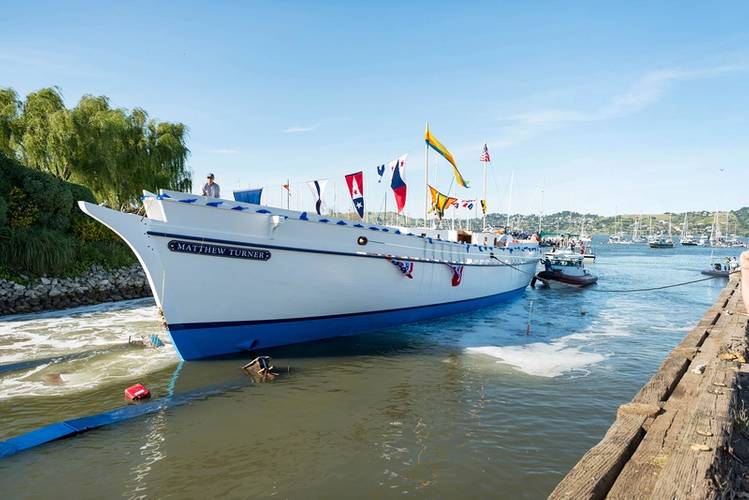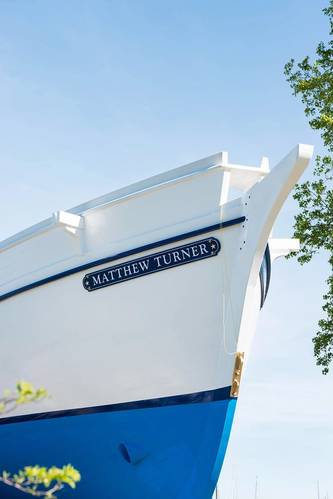Old photos show mid-nineteenth century sailing ships abandoned in the San Francisco Bay area by crews who caught gold fever. Some of these abandoned hulls lie under the modern day city of San Francisco. Over in Sausalito, just to the north of the famous Golden Gate Bridge, what may well be the spirit of one of those buried vessels has taken shape under the direction of Captain Alan Olson, who has several decades of experience building and restoring and sailing classic wooden ships. Olson also started a non-profit organization, Call of the Sea, which is dedicated to preserving maritime traditions while teaching the skills of seamanship and teamwork and marine ecology through the organization’s sailing programs.
Named the Matthew Turner, after a celebrated 19th century Bay-Area ship builder, the two-masted brigantine is 100 ft. long on her deck and 132-ft.overall. Based on lines from the Galilee, one of her namesake’s ships, the modification and details have been done by noted tall ship designers, Tri-Coastal Marine of Richmond, California. http://www.tricoastal.com/index.html
While the hull, rigging and sail power may derive from late nineteenth century designs; the ship’s auxiliary power is as up to date as today’s newspaper. The propulsion system is a hybrid of diesel-powered generator, batteries and even an electrical power-generating propeller.
David Adamiak, of BAE Systems, supplier of the HybriGen®, explained some of the features of the system that incorporates a pair of Cummins QSB6.7 diesel engines rated at 301 HP each. “In this application, there is no mechanical connection between the QSB6.7 engines and the prop shafts,” he continued the explanation, “It is best to think of the architecture as two variable speed hybrid generators that deliver electrical power to where it is needed when it is needed. Essentially, they deliver power-on-demand for (a) electrical propulsion; or (b) hotel loads; or (c) any combination of the two. The system controller decides whether to pull the needed power from the Energy Storage System (ESS), composed of Li-ion batteries, or the diesel engine, depending upon which is most efficient for the desired load. Thus, in this application, the speed of the diesel engine will not be constant, but rather will be dependent upon the electrical load, so that it is always running at its most efficient point to minimize fuel consumption and emissions.”
The complex beauty of the system is remarkable in it-self, but gets even more exciting. When the Matthew Turner will be travelling under sail, the batteries will be charging. With the diesel engines stopped, the water flowing over the hull will continue to turn the electric motor via the propeller and its shaft. This will, similarly to a hybrid car going down hill, cause the electric propulsion motors to become generators to produce electricity to recharge the batteries. Wind power creates waterpower, which turns the prop, to create electrical power. Amazing.
As the propulsion components were being put together by BAE Systems, the boat builders over at Sausalito were finishing the hull planking. As master shipwright Alan Olson explained to Chris Lo of Ship-technology.com in August of 2015, “…a big challenge is planking. We have 230 planks going on; they're three inches thick, they're between 14 and 27 feet long, and it just takes a lot to get those planks on.”
With the planking completed in 2016, interior work continued. With a lot of the work being completed by dedicated volunteers the excitement of the launch finally arrived on April 1, 2017. The Matthew Turner web page shows more of the story, and is a good place to stay informed or donate to the project. http://educationaltallship.org/index.php As of the launch date the ship’s hull and interiors are largely finished. Additional plumbing and wiring will continue dockside. The final, and perhaps most exciting stage, is the placement of the masts and the completion of the complex rigging. Current plans will see the ship ready for sea trials sometime in October of this year.















